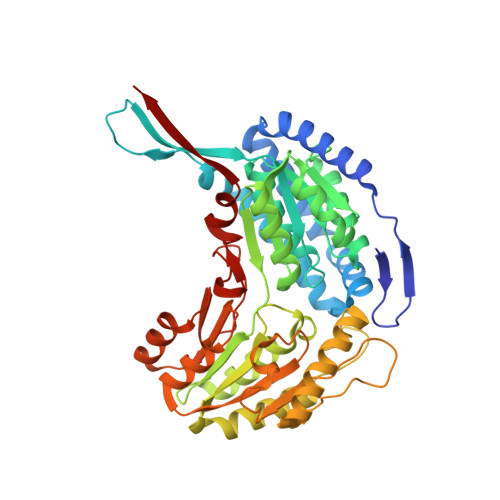Structural Basis for a Cofactor-dependent Oxidation Protection and Catalysis of Cyanobacterial Succinic Semialdehyde Dehydrogenase.
Park, J., Rhee, S.(2013) J Biol Chem 288: 15760-15770
- PubMed: 23589281
- DOI: https://doi.org/10.1074/jbc.M113.460428
- Primary Citation of Related Structures:
4IT9, 4ITA, 4ITB - PubMed Abstract:
Succinic semialdehyde dehydrogenase (SSADH) from cyanobacterium Synechococcus differs from other SSADHs in the γ-aminobutyrate shunt. Synechococcus SSADH (SySSADH) is a TCA cycle enzyme and completes a 2-oxoglutarate dehydrogenase-deficient cyanobacterial TCA cycle through a detour metabolic pathway. SySSADH produces succinate in an NADP(+)-dependent manner with a single cysteine acting as the catalytic residue in the catalytic loop. Crystal structures of SySSADH were determined in their apo form, as a binary complex with NADP(+) and as a ternary complex with succinic semialdehyde and NADPH, providing details about the catalytic mechanism by revealing a covalent adduct of a cofactor with the catalytic cysteine in the binary complex and a proposed thiohemiacetal intermediate in the ternary complex. Further analyses showed that SySSADH is an oxidation-sensitive enzyme and that the formation of the NADP-cysteine adduct is a kinetically preferred event that protects the catalytic cysteine from H2O2-dependent oxidative stress. These structural and functional features of SySSADH provide a molecular basis for cofactor-dependent oxidation protection in 1-Cys SSADH, which is unique relative to other 2-Cys SSADHs employing a redox-dependent formation of a disulfide bridge.
Organizational Affiliation:
Department of Agricultural Biotechnology, Seoul National University, Seoul 151-921, Korea.
















